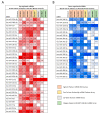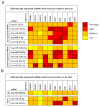Identification of Modulated MicroRNAs Associated with Breast Cancer, Diet, and Physical Activity
- PMID: 32911851
- PMCID: PMC7564431
- DOI: 10.3390/cancers12092555
Identification of Modulated MicroRNAs Associated with Breast Cancer, Diet, and Physical Activity
Abstract
Background: Several studies have shown that healthy lifestyles prevent the risk of breast cancer (BC) and are associated with better prognosis. It was hypothesized that lifestyle strategies induce microRNA (miRNA) modulation that, in turn, may lead to important epigenetic modifications. The identification of miRNAs associated with BC, diet, and physical activity may give further insights into the role played by lifestyle interventions and their efficacy for BC patients. To predict which miRNAs may be modulated by diet and physical activity in BC patients, the analyses of different miRNA expression datasets were performed. Methods: The GEO DataSets database was used to select miRNA expression datasets related to BC patients, dietary interventions, and physical exercise. Further bioinformatic approaches were used to establish the value of selected miRNAs in BC development and prognosis. Results: The analysis of datasets allowed the selection of modulated miRNAs associated with BC development, diet, and physical exercise. Seven miRNAs were also associated with the overall survival of BC patients. Conclusions: The identified miRNAs may play a role in the development of BC and may have a prognostic value in patients treated with integrative interventions including diet and physical activity. Validation of such modulated miRNAs on BC patients undergoing lifestyle strategies will be mandatory.
Keywords: bioinformatics; biomarkers; breast cancer; diet; epigenetic; microRNA; physical activity; prognosis.
Conflict of interest statement
The authors declare no conflict of interest.
Figures










References
-
- Carayol M., Ninot G., Senesse P., Bleuse J.P., Gourgou S., Sancho-Garnier H., Sari C., Romieu I., Romieu G., Jacot W. Short- and long-term impact of adapted physical activity and diet counseling during adjuvant breast cancer therapy: The “APAD1” randomized controlled trial. BMC Cancer. 2019;19:737. doi: 10.1186/s12885-019-5896-6. - DOI - PMC - PubMed
Grants and funding
LinkOut - more resources
Full Text Sources

